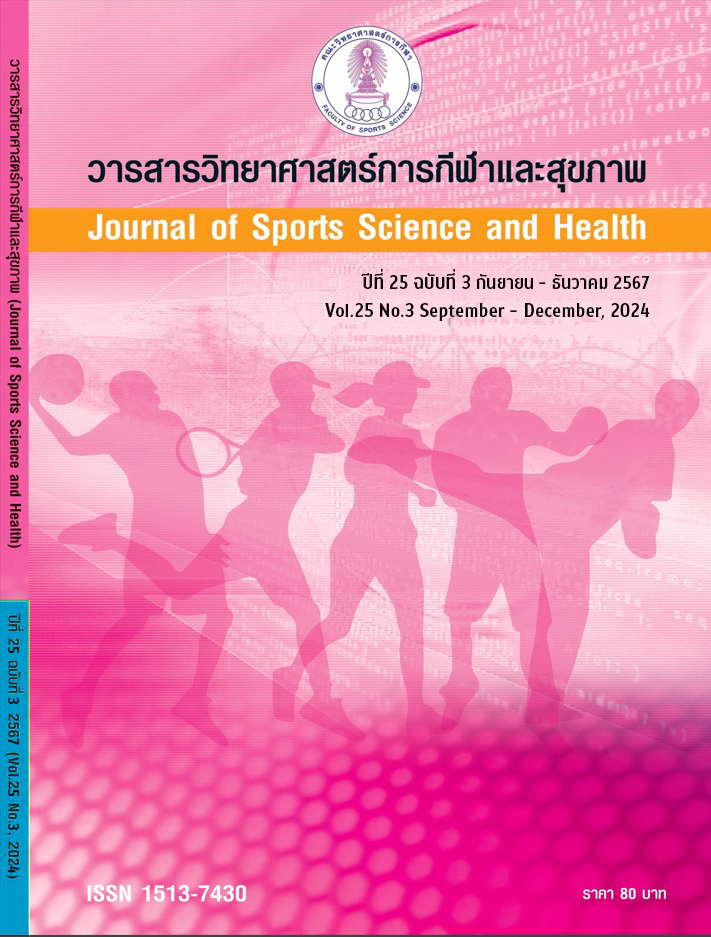THE EFFECTS OF POWER YOGA TRAINING ON PHYSICAL FITNESS IN FEMALE COLLEGE VOLLEYBALL PLAYERS
Main Article Content
Abstract
Purpose
This study aimed to investigate the effects of power yoga training on physical fitness in female college volleyball players.
Methods
This study aimed to investigate the effects of power yoga training on physical fitness in female college volleyball players. Twenty female college volleyball players, aged between 18-25 years, participated in this study. All subjects, matched 1RM relative 110 degrees back squat, were randomly assigned into two groups. The control group (n=10) performed stretching training and the experimental group (n=10) performed power yoga training. Both groups engaged in supervised training program twice a week for 8 weeks relative strength, power, flexibility of hip, knee, and ankle and balance were measured before, after the 4 weeks and after the 8 weeks of training. Data were expressed as mean± standard deviation and were analyzed using independent sample t-test and one-way repeated measures analysis of variance (ANOVA) with Bonferroni post-hoc tests applied for pairwise comparison Significance level at p-value <0.05.
Results
The results showed that no significant differences in relative strength, peak power, peak velocity, peak force, ankle flexibility, hip flexibility, knee flexibility, sway index and stability index were found between and within groups before and after 4 weeks of training (p>0.05). After 8 weeks of training, the control group showed that significant improvements in hip flexibility and the experimental group showed that significant improvements in relative strength, peak power, peak force, ankle flexibility, knee flexibility, hip flexibility and stability index compared to before training (p<0.05). The peak power, peak force, stability index of the experimental group was significantly better than that the control group after 8 weeks of training (p<0.05).
Conclusion
Our results demonstrated that the power yoga training is an effective training for enhancing muscular power, balance, and flexibility. Therefore, coaches and athletes are encouraged to incorporate the power yoga training to enhance power, balance and flexibility of female college volleyball players.
Article Details

This work is licensed under a Creative Commons Attribution-NonCommercial-NoDerivatives 4.0 International License.
References
Baechle, T. R., and Earle, R. W. (Eds.). (2008). Essentials of strength training and conditioning. Champaign: Human kinetics.
Birch, B. B. (2010). Power yoga: the total strength and flexibility workout. New York: Simon and Schuster.
Boccolini, G., Brazzit, A., Bonfanti, L., and Alberti, G. (2013). Using balance training to improve the performance of youth basketball players. Sport Sciences for Health, 9(2), 37-42.
Bompa, T., and Buzzichelli, C. (2021). Periodization of strength training for sports. Champaign: Human kinetics.
Bompa, T. O., and Stoenescu, G. (1996). Power training for sport: Plyometrics for maximum power development. Ottawa: Coaching association of Canada.
Carter, R. (2001). Working with texts: a core introduction to language analysis. Bangkok: Psychology Press.
Martin, A. C., and Candow, D. (2019). Effects of online yoga and tai chi on physical health outcome measures of adult informal caregivers. International Journal of Yoga, 12(1), 37-44.
Marieb, E. N., and Hoehn, K. (2015). Human anatomy & physiology. London: Pearson education.
Medeiros, A., Marcelino, R., Mesquita, I., and Palao, J. M. (2014). Physical and temporal characteristics of under 19, under 21 and senior male beach volleyball players. Journal of Sports Science and Medicine, 13(3), 658-665.
Mueller, P. A., Wooden, J. L., and Nutman, A. P. (1992). 3.96 Ga zircons from an Archean quartzite, Beartooth Mountains, Montana. Geology, 20(4), 327-330.
O'Shea, P. (2000). Quantum Strength Fitness II: Gaining the Winning Edge: Applied Strength Training & Conditioning for Peak Performance. Florida: Patrick's books.
Panchitta, S. (2021). Strengthening the body with yoga. Research and Development Institute Journal Chaiyaphum Rajabhat University, 3(2), 15-28.
Parsuraman, T., Krishnan, B. S., Harigaran, D., and Balamurugan, K. (2022). Investigation on the changes of inspiratory reservevolume due to different intensities of circruit training among male football players. Journal of Positive School Psychology, 6(4), 7949-7953.
Pauk, D. (2022). Warm-Up and stretching practices in soccer players-a survey analysis. Master’s thesis, Department of Kinesiology, California State University, Long Beach. Long Beach.
Polglaze, T., and Dawson, B. (1992). The physiological requirements of the specialist positions in volleyball. Sports Coach, 15(1), 32-37.
Roberts, K. J. (2004). Yoga for golfers: a unique mind-body approach to golf fitness. New York: McGraw-Hill.
Salee, S. (2003). Yoga and muscle stretching for health. Bangkok: Prasarnmit.
Salee, S. (2004). Iyenka Yoga Textbook. Bangkok: Fueangfa Printing.
Shiraishi, J. C., and Bezerra, L. M. (2016). Effects of yoga practice on muscular endurance in young women. Complementary Therapies in Clinical Practice, 22, 69-73. https://doi.org/10.1016/j.ctcp.2015.12.007
Shumway-Cook, A., and Woollacott, M. (2000). Attentional demands and postural control: the effect of sensory context. The Journals of Gerontology, 55(1), 10-16.
Skultetyova, D., Czakova, M., KovaCova, N., and Sutka, V. (2019). Influence of power yoga on the explosive strength of upper and lower limbs and heart performance of dancers. International Journal of Yoga, Physiotherapy and Physical Education, 4(6), 1-5.
Sonthaya, S. (2012). Principles of sports training for sports coaches. Bangkok: Chulalongkorn University.
Tamizhmaran, K., and Pushpa, P. M. (2020). Effect of power yoga and pranayama practices on selected physical and physiological variables among intercollegiate sports men. International Journal of Applied Research, 6(8), 190-194.
Tillman, M. D., Hass, C. J., Brunt, D., and Bennett, G. R. (2004). Jumping and landing techniques in elite women’s volleyball. Journal of Sports Science and Medicine, 3(1), 30-36.
Umberger, B. R. (1998). Mechanics of the vertical jump and two-joint muscles: implications for training. Strength and Conditioning Journal, 20(5), 70-74.
Urasanit, M., & Apanukul, S. (2020). Acute Effects of Squat Jump with Different Weights on Peak Power in Female Volleyball Players. Journal of Sports Science and Health, 21(1), 75-83.


